“Visions of Progress: Portraits of Dignity, Style, and Racial Uplift,” a new exhibition at the University of Virginia’s Albert and Shirley Small Special Collections Library, showcases portraits that African Americans in central Virginia commissioned from the Holsinger Studio during the first decades of the 20th century. The photographs expressed the individuality of the women and men who commissioned them, while silently yet powerfully asserting their claims to rights and equality. Opening Sept. 22, the exhibition is the result of years of research by UVA professors, students, and community members.
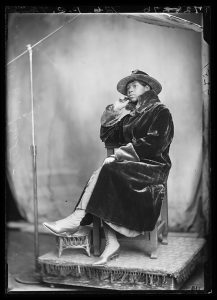
John Edwin Mason, a UVA associate professor of history and a documentary photographer, first learned about the Holsinger Studio Collection, held in the Small Special Collections Library, when he saw a small exhibition at the UVA’s Woodson Institute, curated by the late professor Reginald Butler and professor Scot French (now of the University of Central Florida) in 1998. The collection, which UVA acquired in 1978, includes about 10,000 glass plate negatives taken by the Holsinger Studio of life in Charlottesville and Albemarle and Nelson counties from the 1890s to the 1920s. Many of the photographs were commissioned portraits and more than 600 of those portraits are of African American citizens in central Virginia. Mason was immediately intrigued.
“I thought that we could use these portraits not simply to enjoy for their beauty as aesthetic objects, but we could see history through them, we could tell history through them. By researching the lives of the people in the photographs, we can learn a lot about the history of this place,” he said.
The portraits were taken during the height of the Jim Crow era, when state laws enforced racial segregation in the South, the Ku Klux Klan had local chapters in the Albemarle region, and a wealthy, white UVA alumnus successfully commissioned two statues of Confederate leaders (Robert E. Lee and Thomas “Stonewall” Jackson) to be erected in Charlottesville parks. “It was an incredibly oppressive time,” Mason said. “But the magic of these portraits is that you don’t see the oppression in them. And that was intentional on the part of the people who had their images made. They are saying, ‘We are not who you think we are. We are not those stereotypes, we are not defined by our status in Jim Crow society.”
A community effort
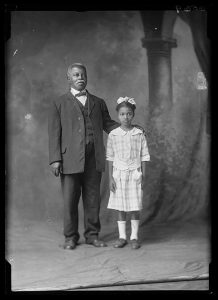
In 2015, Mason turned his interest in the photos into action. He launched the Holsinger Studio Portrait Project, to delve into the lives of the portrait subjects; a partnership with the Institute for Advanced Technology in the Humanities director Worthy Martin in 2018 provided the project with a web presence to share their research. With a 3Cavaliers grant from the office of UVA’s Vice President for Research, the team was able to hire seven undergraduate students to examine census records, military records, birth and death certificates, and African American newspapers from surrounding regions. They also dug through personal papers in UVA Special Collections to find original Holsinger prints, giving the students information about the people in the portraits and about central Virginia during that era.
A grant from Virginia Humanities allowed the team to begin reaching out to the local community to help identify portrait subjects. In 2019, the project partnered with the Jefferson School African American Heritage Center to host a “Family Photo Day,” where participants could examine the Holsinger Studio portraits in flipbooks and add comments if they had any information about the subjects. “We had over 300 people come to our Family Photo Day,” Mason said. “That was a moment where we could see the potential for the project; we could see how engaged and how excited people were by these portraits.”
That same year, the team also installed 30 of the portraits around the Memorial to Enslaved Laborers construction site, drawing attention from hundreds of passers-by each day. Two Charlottesville community members, Descendants of Enslaved Communities at UVA co-chair DeTeasa Brown Gathers (who found a photo of her great-great grandmother in the Holsinger Studio Collection) and local realtor Edwina St. Rose, joined the project as community advisors. Working with the group The Preservers of the Daughters of Zion Cemetery, they launched an exhibit of the portraits at CitySpace in downtown Charlottesville in the summer of 2019.
A significant grant from the Jefferson Trust earlier this year, awarded to the University’s Corcoran Department of History, IATH, and the UVA Library, is supporting the team to think more broadly about a community engagement program. In March, the team launched a pop-up exhibit of the Holsinger photos at the Northside branch of the Jefferson-Madison Regional Library. “Our trustees were fascinated to learn that such an interesting collection of African American history is held by the University,” said Amy Bonner, director of grants at the Jefferson Trust. “The opportunity to help launch such a powerful exhibition and support the associated research was impossible to pass up.”
Viola Green Porter (1898-1985) commissioned this portrait to commemorate her graduation from the eighth grade at Charlottesville’s segregated Jefferson Graded School. The white dress and diploma make this photo similar to other Holsinger Studio graduation portraits of young women, both Black and white.
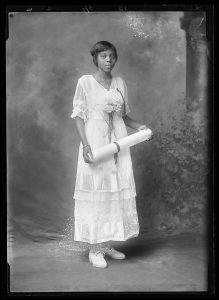
The grant is also supporting the “Visions of Progress” exhibition launching Sept. 22 in the Main Gallery of the Small Special Collections Library, where visitors can view almost 100 Holsinger Studio portraits and take in the biographical information about the subjects unearthed over the past few years by the Holsinger Studio Portrait Project team. They can also learn about the “New Negro” movement that countered the Jim Crow oppression of the early 20th century, stemming from Black intellectual leaders Booker T. Washington, Alain LeRoy Locke, and Charlottesville native George W. Buckner, whose manifesto, “The New Negro,” caused an uproar when the Charlottesville Messenger, the city’s Black newspaper, published it in 1921. “The New Negro the country over is coming to see that his salvation is in his own hands,” Buckner wrote.
The portraits in the exhibit reflect this ethos, Mason said. “It’s important to emphasize that even though the people in the portraits are dressed to the nines, they are everyday people. Most had working-class jobs.” By dressing so beautifully, Mason said, the portrait sitters were pushing back against racist caricatures that were common in American media during that era. “There was dynamism within the African American community,” he said. “Immediately after the ratification of the 19th Amendment, over 100 African American women registered to vote in Charlottesville. Black people were running barber shops, running blacksmith shops, running laundries, and campaigning for a high school. People were not defined by their oppression.”
Vibrant portraits
In 2020, Holly Robertson, Curator of University Library Exhibitions, reached out to Mason to suggest co-sponsoring an exhibition after seeing the enthusiasm the Holsinger Portrait Project garnered on Grounds in the community.
“The Holsinger Studio portraits have been an important part of the UVA Library’s collections since the 1970s,” Robertson said. “We’ve done so much work to describe and provide access to the collection — it was one of the first photographic collections we fully digitized in the late 1990s, and each portrait is available online through Virgo. We’ve taken painstaking care to provide the best preservation environment for the fragile glass plate negatives as well as the business ledgers. Yet, we’ve never exhibited this collection. As the Holsinger Studio Portrait Project grew, we saw a wonderful opportunity to partner in telling the stories of Black central Virginians through our amazing collections.”
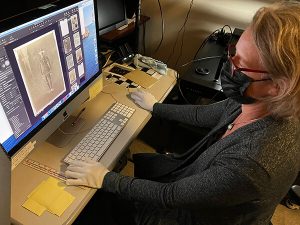
UVA Library staff played a crucial role in preparing the portraits for the Special Collections exhibition. Stacey Evans, an imaging specialist and project coordinator for the Library, led a team in rephotographing the glass-plate negatives to capture plate identification numbers that had been cropped in scanning efforts in the 1990s. This helped to identify photo subjects. By following standards set by the Federal Agencies Digital Guidelines Initiative, Cultural Heritage Imagining, and the Library of Congress, Evans and her team then took their photographic reproductions of the negatives and created “artist’s renderings” of the portraits using Photoshop.
Evans, a photographer who has nearly 30 years of experience scanning negatives and working in digital imaging, said that when comparing the original scans of the negatives in Virgo to the images her team created, the tonal range of the portraits has dramatically improved. “On a personal note,” she said, “John Mason and I have been friends in the Charlottesville photo community for many years. It’s an honor to work with him on this project.”
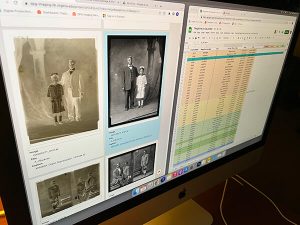
Brandon Butler, the Library’s Director of Information Policy, conducted extensive research on copyright issues pertaining to the Holsinger collection to prepare for the exhibition. “Perhaps surprisingly, some portraits in the Holsinger Studio Collection are still subject to copyright regulations more than 100 years after they were created,” Butler said. “We believe the portrait copyrights belonged to whoever paid to have them taken — often the subject or a relative. Because that right would endure for 120 years, the descendants of the portrait sitters may still hold rights to their ancestors’ images.”
Mason and Library staff members urge exhibition visitors who might recognize ancestors or have any information about the portrait subjects to email the team at
HolsingerStudio@virginia.edu. A brochure of the portraits will be freely available at the opening, and the Holsinger Project website, built by IATH, will live on after the exhibition ends in June 2023. With further support from the Jefferson Trust grant, the Holsinger Studio Project will continue to bring the portraits into the local community, visiting schools, religious organizations, and civic groups. An exhibition at the Jefferson School African American Heritage Center curated by Andrea Douglas, the center’s Executive Director, is in development.
“We want to change the way that everyone in central Virginia sees our shared history,” Mason said.
Public exhibition opening details

The public opening celebration for “Visions of Progress: Portraits of Dignity, Style, and Racial Uplift” will be held on Sept. 22 in the Main Gallery of UVA’s Albert and Shirley Small Special Collections Library from 5-8 p.m.
John Edwin Mason will host two rounds of gallery talks that evening: one at 5:30 p.m., another at 6:30 p.m.
Kendall King and Jalane Schmidt, curators of another UVA Library exhibition, “No Unity Without Justice: Student and Community Organizing During the 2017 Summer of Hate,” will speak in the First Floor Gallery at 6 and 7 p.m.
This event is free, but registration is required: 100 tickets will be released via EventBrite for the 5:30/6:00 talks, and another 100 for the 6:30/7:00 talks. Register here: https://Visions-UVA.eventbrite.com
A shuttle will run from the Jefferson School African American Center to the Albert and Shirley Small Special Collections Library at UVA every 30 minutes from 4-8 p.m. for the public opening celebration on September 22, 2022. Registered attendees may also request a code to park for free in the Central Grounds Garage.
For reporters
For press inquiries, please contact Elyse Girard at elyse@virginia.edu.
